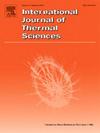直流塑壳断路器闪弧现象的传热与流体流动研究:模型优化与结构改进
IF 4.9
2区 工程技术
Q1 ENGINEERING, MECHANICAL
International Journal of Thermal Sciences
Pub Date : 2025-04-11
DOI:10.1016/j.ijthermalsci.2025.109919
引用次数: 0
摘要
随着断路器分断能力的提高,在大电流分断情况下发生弧闪现象的频率也大幅上升。然而,对此类设备内部弧闪现象的数值研究仍然有限,大多数研究仍处于早期阶段。由于直流塑壳断路器(DC-MCCB)内部环境的复杂性,高能等离子体电弧的多场耦合模拟面临巨大挑战。本研究进行了实验比较,以研究在恒定驱动磁场和不同分断电流水平下直流塑壳断路器中的电弧运动和弧闪模式演变。利用磁流体力学 (MHD),开发了一种考虑到阿基米德力(浮力)的改进电弧模型,用于分析弧闪现象中的流体流动、传质和传热机制。针对这一现象提出了若干结构改进建议,并对优化方案进行了实验验证。结果表明,在 DC-MCCB 的电弧室中,气流分散效应会在电弧流道弯曲处产生反向涡流,从而削弱电弧的浮力。此外,强大的洛伦兹力会导致下部的高能电弧被切断,移动速度过快,阻碍散热,从而限制了分流板的利用率。这导致电弧在分流板区域的能量分布不均,是产生弧闪现象的主要原因。改进后的双侧出气口结构可以增加电弧室上方的气体流速,保持前向涡流升力,提高分流板的利用率。改进的绝缘气体发生劈裂板结构可以限制弧能在劈裂板下部区域的积累,增加弧室压力,提高介质的传热系数,从而降低弧闪能量。通过多因素、多层次的正交实验,对抑制弧闪措施的参数进行了综合优化,为直流-多相交流放电管新结构的再设计提供了理论依据和指导价值。本文章由计算机程序翻译,如有差异,请以英文原文为准。
Investigation on heat transfer and fluid flow of arc-flash phenomenon in DC molded case circuit breakers: Model optimization and structural improvement
With the increase in circuit breaker interrupting capacity, the frequency of arc-flash phenomena under high-current interruptions rises significantly. However, numerical studies on internal arc-flash phenomena in such equipment are still limited, with most research remaining in its early stages. Due to the complexity of the internal environment in DC molded case circuit breakers (DC-MCCBs), multi-field coupling simulations of high-energy plasma arcs present substantial challenges. This study conducts experimental comparisons to investigate the arc motion and arc-flash pattern evolution in DC-MCCBs under a constant driving magnetic field and varying interrupting current levels. Using magnetohydrodynamics (MHD), an improved arc model accounting for Archimedes force (buoyancy) is developed to analyze the fluid flow, mass transfer, and heat transfer mechanisms within the arc-flash phenomenon. Several structural improvements are proposed to address this phenomenon, with experimental validation of the optimizations. The results show that in the arc chamber of the DC-MCCB, the airflow dispersion effect causes a reverse vortex at the bend of the arc runner, weakening the arc's buoyancy. Additionally, the strong Lorentz force causes the high-energy arc in the lower section to be cut off and move too rapidly, impeding heat dissipation, which limits the utilization of the splitter plates. This results in uneven energy distribution of the arc in the splitter plate region and is the primary cause of the arc-flash phenomenon. The improved dual-side air outlets structure can increase the gas flow rate above the arc chamber, maintaining the forward vortex lift and enhancing the utilization of the splitter plates. The improved insulated gas-generating splitter plate structure can limit arc energy accumulation in the lower splitter region, increase arc chamber pressure, and improve the heat transfer coefficient of the medium, thereby reducing arc-flash energy. Through multi-factor, multi-level orthogonal experiments, comprehensive parameter optimization for arc-flash suppression measures is conducted, providing theoretical foundation and guiding value for the redesign of the new structure of DC-MCCB.
求助全文
通过发布文献求助,成功后即可免费获取论文全文。
去求助
来源期刊

International Journal of Thermal Sciences
工程技术-工程:机械
CiteScore
8.10
自引率
11.10%
发文量
531
审稿时长
55 days
期刊介绍:
The International Journal of Thermal Sciences is a journal devoted to the publication of fundamental studies on the physics of transfer processes in general, with an emphasis on thermal aspects and also applied research on various processes, energy systems and the environment. Articles are published in English and French, and are subject to peer review.
The fundamental subjects considered within the scope of the journal are:
* Heat and relevant mass transfer at all scales (nano, micro and macro) and in all types of material (heterogeneous, composites, biological,...) and fluid flow
* Forced, natural or mixed convection in reactive or non-reactive media
* Single or multi–phase fluid flow with or without phase change
* Near–and far–field radiative heat transfer
* Combined modes of heat transfer in complex systems (for example, plasmas, biological, geological,...)
* Multiscale modelling
The applied research topics include:
* Heat exchangers, heat pipes, cooling processes
* Transport phenomena taking place in industrial processes (chemical, food and agricultural, metallurgical, space and aeronautical, automobile industries)
* Nano–and micro–technology for energy, space, biosystems and devices
* Heat transport analysis in advanced systems
* Impact of energy–related processes on environment, and emerging energy systems
The study of thermophysical properties of materials and fluids, thermal measurement techniques, inverse methods, and the developments of experimental methods are within the scope of the International Journal of Thermal Sciences which also covers the modelling, and numerical methods applied to thermal transfer.
 求助内容:
求助内容: 应助结果提醒方式:
应助结果提醒方式:


